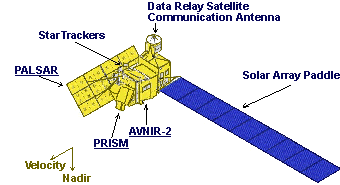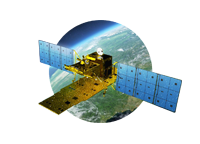The Japanese Earth observing satellite program consists of two series: those satellites used mainly for atmospheric and marine observation, and those used mainly for land observation. The Advanced Land Observing Satellite (ALOS) follows the Japanese Earth Resources Satellite-1 (JERS-1) and Advanced Earth Observing Satellite (ADEOS) and will utilize advanced land-observing technology. ALOS will be used for cartography, regional observation, disaster monitoring, and resource surveying.

The ALOS has three remote-sensing instruments: the Panchromatic Remote-sensing Instrument for Stereo Mapping (PRISM) for digital elevation mapping, the Advanced Visible and Near Infrared Radiometer type 2 (AVNIR-2) for precise land coverage observation, and the Phased Array type L-band Synthetic Aperture Radar (PALSAR) for day-and-night and all-weather land observation. In order to utilize fully the data obtained by these sensors, the ALOS was designed with two advanced technologies: the former is the high speed and large capacity mission data handling technology, and the latter is the precision spacecraft position and attitude determination capability. They will be essential to high-resolution remote sensing satellites in the next decade. ALOS have been successfuly launched on an H-IIA launch vehicle from the Tanegashima Space Center, Japan.
| Launch Date | Jan. 24, 2006 |
|---|---|
| Launch Vehicle | H-IIA |
| Launch Site | Tanegashima Space Center |
| Spacecraft Mass | Approx. 4 tons |
| Generated Power | Approx. 7 kW (at End of Life) |
| Design Life | 3 -5 years |
| Orbit | Sun-Synchronous Sub-Recurrent |
| Repeat Cycle: 46 days Sub Cycle: 2 days |
|
| Altitude: 691.65 km (at Equator) | |
| Inclination: 98.16 deg. | |
| Attitude Determination Accuracy | 2.0 x 10-4degree (with GCP) |
| Position Determination Accuracy | 1m (off-line) |
| Data Rate | 240Mbps (via Data Relay Technology Satellite) 120Mbps (Direct Transmission) |
| Onboard Data Recorder | Solid-state data recorder (90Gbytes) |
ALOS is one of the largest Earth observing satellites ever developed. Its objectives are:
- (1) to provide maps for Japan and other countries including those in the Asian-Pacific region (Cartography)
- (2) to perform regional observation for "sustainable development", harmonization between Earth environment and development (Regional Observation),
- (3) to conduct disaster monitoring around the world (Disaster Monitoring),
- (4) to survey natural resources (Resources Surveying),
- (5) to develop technology necessary for future Earth observing satellite (Technology Development)










